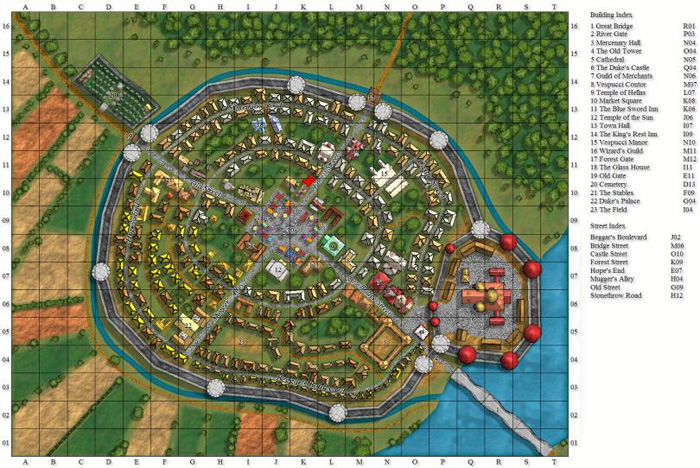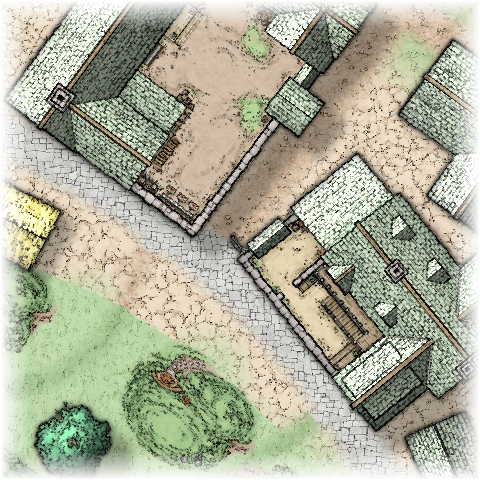

net has a useful linear approach to mapping. I should point out that there is Node Based mapping for megadungeons. Dyson’s Vertical Morphology Honorable Mentions 1981 D&D Basic Rulebook Stonewerks Vertical Geomorphs. I stared at this picture constantly and tried my hand at drawing my own.

My first introduction to a vertical dungeon map was in 1981 with the vertical map in the D&D Basic book.

It became so popular that Profantasy even made a mapping anual for vertical dungeons in 2011. About ten years ago this became quite the craze kicked off by Stonewerks’s and Dyson. D3: Vault of the Drow by Gary Gygax, TSR, 1978Īnother way of showing depth and scope, other than 3D modeling everything or isomorphic mapping, is to use a 2D side view. I like this idea as it allows the players to travel farther afield without having to map out the entire four day journey which would bore even the most OCD of gaming mappers. Again this is a concept utilized by Gary Gygax in 1978.
#PROFANTASY CITY DESIGNER FULL#
Encounter AreasĮncounter areas can be anything from a point of interest, to something special about the passage, to a small series of rooms, to a full blown dungeon area. Just an example of how I might use the regional map grid to scale in more detailed areas. Whatever scale I end up with will be in some way able to scale perfectly with my 7″ modular tiles so I can make some modular dungeon on the quick and slot them in. I’ve kept a hexagon grid system on the regional map so that I might scale in to more detailed areas (see image below) I will also be able to link up other regional maps in the future to this one thus increasing the size of the dungeon. I will be including some dashed and dotted routes to indicate lesser used to secret routes. This could indicate an elevator, stairs, shaft, or a sloped raise from 2-6 without any exits between the other levels. Following the Level 2 route from Silkdown it suddenly raises from level 2 to level 6. So it would be safe to say that it has at least two levels, although this is not always the case. Now the colour of which it intersects with a Burrow can indicate how many levels it has. Hidden is the extensive version but I don’t want them seeing those yet.Īs you can see from the maps above the region map will represent eight levels. The beginning of the Campaign Region map (work in progress) This map is the players map and shows only areas that will be known to them. I may make an isometric map once I get enough points created A very quick mock up of how the line colour represents that it is on a different level. However I’m not making a rail system I’m designing a Megadungeon! So I propose to make an elevation colour meter to give a sense of what level the routes are. Now on a transit map, which now has a pretty standardised look worldwide thanks to Harry Beck’s 1933 London Underground Map, each rail line as a designated colour. It just means the players will not be mapping and exploring those points at this time. This doesn’t mean that there is nothing between point A and point B. Along the indicated route you have marker points that represent either encounter points, Burrows (Residential Towns), or large campaign size dungeon. Each “transit line” would represent the main route, whether it is a long winding cavern, a massively wide corridor, or a tiny one yard wide passage. This frees up the GM from having to make miles of rooms and corridors that will never get explored. Gygax came up with an easy system, much like a transit map, of showing the players where they were in relation to where they have been, albeit in an abstract form. Dungeon Module D1 Descent Into the Depths of the Earth. I was pretty pleased with myself until I realised that Gary Gygax had done almost the same thing in 1978 (two years before I discovered D&D) with Dungeon Module D1 Descent Into the Depths of the Earth. I first got the idea of using a Transit Style map for a quick abstract guide back in 2010 with Profantasy Softwares May 2010 Annual “Abstract Maps”. If my Megadungeon is endless then I should make some kind of “overland” map to get an idea of where the players may be heading so I know what lies ahead (or below). This hasn’t stopped me from wanting to run an epic megadungeon game which is why I’ve been slowly coming up with a fantasy setting that takes place completely underground. My last attempt at a Megadungeon was to convert Dungeon Crawl Classic #51 Castle Whiterock and that lasted for two levels before the group disbanded due to some moving away, others not able to schedule game time in due to real life commitments. If you read the multitude of blogs out there Campaigns rarely last for more than a year or two before either the players get bored or the GM gets burnout.


 0 kommentar(er)
0 kommentar(er)
